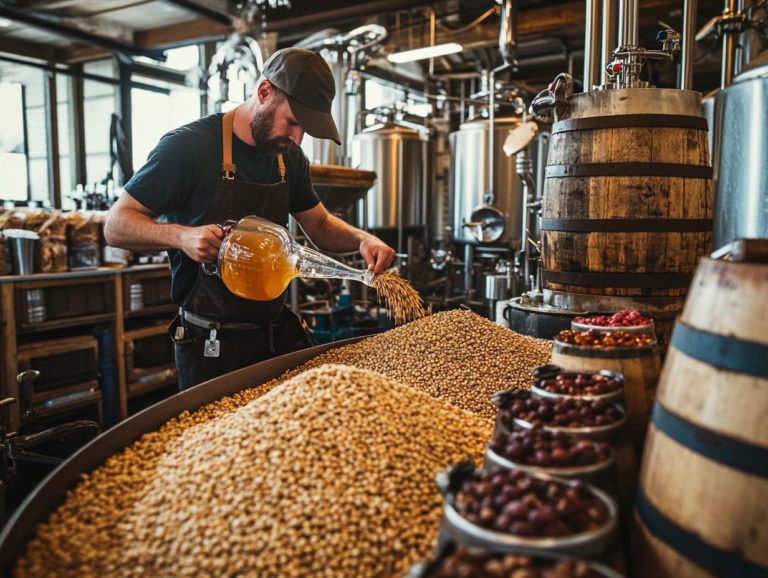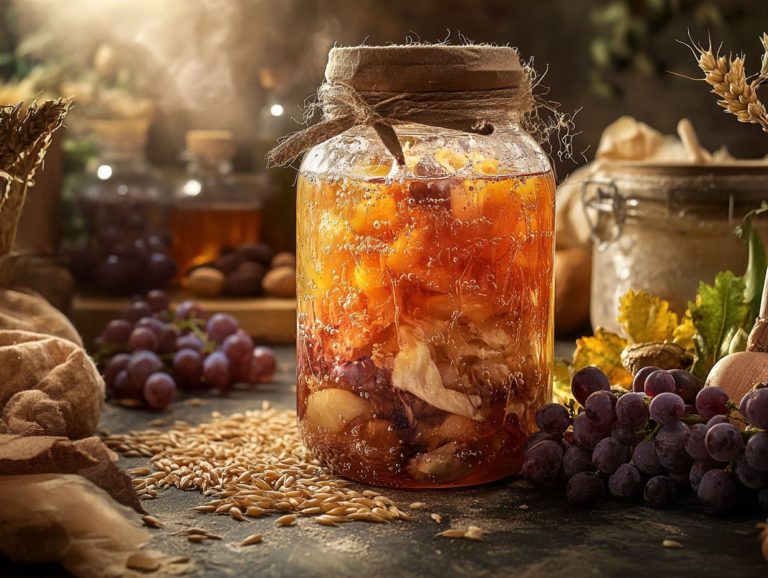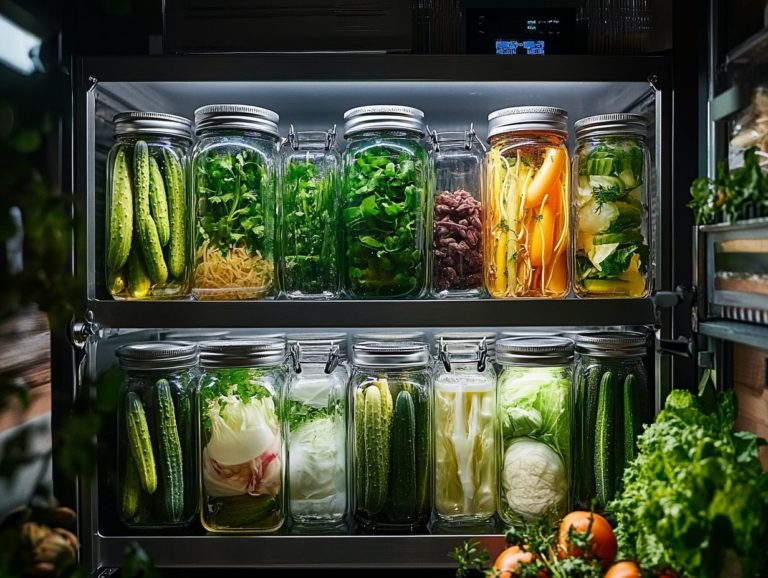How to Experiment with Fermentation Flavors
Fermentation offers you more than just a means of preservation. It invites you into a vibrant culinary adventure teeming with exciting flavors and health benefits.
This exploration delves into the captivating process of fermentation, revealing its various types and the incredible flavors you can experiment with. Whether you’re eager to craft tangy sauerkraut, spicy kimchi, or refreshing kombucha, you’ll find all the guidance you need on essential ingredients, equipment, and techniques to embark on this journey.
Learn how to seamlessly incorporate these delightful fermented foods into your daily meals, and troubleshoot any challenges you may encounter along the way. Prepare to unlock the delicious world of fermentation and elevate your culinary repertoire!
Contents
- Key Takeaways:
- What is Fermentation?
- Why Experiment with Fermentation Flavors?
- How to Start Experimenting with Fermentation Flavors?
- What Ingredients Do You Need?
- What Are Some Popular Fermentation Recipes?
- How to Incorporate Fermented Foods into Your Diet?
- What Are Some Tips for Incorporating Fermented Foods into Your Daily Meals?
- How to Troubleshoot Common Fermentation Problems?
- What Are Some Common Issues When Experimenting with Fermentation Flavors?
- How to Fix and Prevent These Problems?
- Frequently Asked Questions
- What are fermentation flavors?
- Why should I experiment with fermentation flavors?
- How do I start experimenting with fermentation flavors?
- What is the best way to control fermentation flavors?
- Are there any health benefits to experimenting with fermentation flavors?
- Is it necessary to use special equipment to experiment with fermentation flavors?
Key Takeaways:
- Experimenting with fermentation flavors can add depth and complexity to your dishes.
- Understanding the process and benefits of fermentation can help you create successful and delicious experiments.
- Starting with simple recipes and incorporating fermented foods into your daily meals can help you develop your own unique flavor combinations.
What is Fermentation?
Fermentation is a fascinating transformation that involves converting carbohydrates into alcohol, gases, and organic acids through the work of microorganisms like bacteria and yeasts. This ancient technique has played a vital role in preserving foods, enhancing flavors and nutritional value, and promoting gut health through the production of probiotics (beneficial bacteria that promote gut health).
Have you noticed how popular fermented foods like kimchi, sauerkraut, kefir, and kombucha have become? Their health benefits, including improved digestion and support for a balanced gut microbiome, make them essential components of a healthy diet in our increasingly health-conscious society.
Enjoying these tasty options is a great way to nourish your body and improve your health.
What is the Process of Fermentation?
The fermentation process is a fascinating journey through a series of biochemical reactions, where microorganisms like bacteria and yeast work their magic, transforming sugars into acids, gases, or alcohol, all depending on whether you re going for anaerobic or aerobic fermentation. Factors such as temperature and the specific yeast strains you choose can dramatically influence the outcome, ultimately affecting the flavor and texture of your final product.
In anaerobic fermentation, the lack of oxygen creates a thriving environment for yeast communities, resulting in the production of ethanol and carbon dioxide essential components for beloved beverages like beer and wine. On the other hand, Lactobacillus steps into the spotlight during lactic acid fermentation, flourishing in low-oxygen conditions and converting sugars into lactic acid. This not only preserves your food but also lends that signature sour flavor you find in delights like yogurt and kimchi.
Embrace the diversity of microorganisms, including wild yeast that can spontaneously ferment fruits; they play a crucial role in developing complex flavors and aromas. As these microorganisms interact with various substrates, the sensory profile of your finished products can range from pleasantly tart to richly aromatic, crafting unique palates that are cherished in culinary traditions around the globe.
Why Experiment with Fermentation Flavors?
Experimenting with fermentation flavors invites you into a realm of culinary creativity, where you have the power to craft unique flavor combinations that not only elevate your favorite dishes but also deliver substantial health benefits.
The spectrum of tastes from the tangy zing of sour kimchi to the deep, earthy richness of root ferments offers limitless opportunities for personal expression in your cooking.
As you delve into various fermentation techniques, you ll also enhance your gut health, thanks to the abundance of probiotics these foods often contain, which support a harmonious gut microbiome.
What are the Benefits of Fermentation?
The benefits of fermentation go far beyond mere preservation. They play a vital role in enhancing your gut health by producing probiotics and prebiotics, essential for maintaining a balanced gut bacteria. Think of fermented foods like yogurt and sauerkraut as your allies, packed with dietary fiber and beneficial bacteria that support digestion and promote overall well-being.
By incorporating these foods into your diet, you might experience improved digestion and enhanced nutrient absorption. You may even notice a stronger immune system. Probiotic-rich options, such as kefir and kimchi, not only add delightful flavors to your meals but also contain active cultures that contribute to your gut health.
Prebiotics found in foods like miso and tempeh act as nourishment for the beneficial bacteria, ensuring they thrive and support a healthy microbiome. This mutual benefit between probiotics and prebiotics highlights the importance of fermented products. They work together to foster an ecosystem that boosts your wellness, lifts your mood, and may even lower your risk of various diseases.
What are the Different Types of Fermentation?
You ll discover a fascinating array of fermentation types, each defined by its distinct processes and outcomes, including lactic acid fermentation, alcoholic fermentation, and acetic acid fermentation.
Take lacto-fermenting vegetables, for example; it employs specific strain cultures to develop those delightful, tangy flavors that can elevate any dish. Wild yeast fermentation can also create surprising flavors and textures.
Lactic acid fermentation primarily involves the conversion of sugars into lactic acid through the action of bacteria such as Lactobacillus and Streptococcus. This process gives rise to foods like yogurt and sauerkraut, which are celebrated for their distinctively sour profiles.
In contrast, alcoholic fermentation is predominantly executed by yeast like Saccharomyces cerevisiae. It transforms sugars into alcohol and carbon dioxide, resulting in beverages like beer and wine, each boasting a rich array of fruity flavors.
Then there s acetic acid fermentation, driven by acetic acid bacteria such as Acetobacter. This fascinating process transforms ethanol into acetic acid, which is crucial for creating vinegar that enhances dishes with its sharp acidity.
Each type of fermentation not only varies in the microorganisms involved but also contributes unique textures and flavors to the vast tapestry of fermented products enjoyed around the globe.
How to Start Experimenting with Fermentation Flavors?
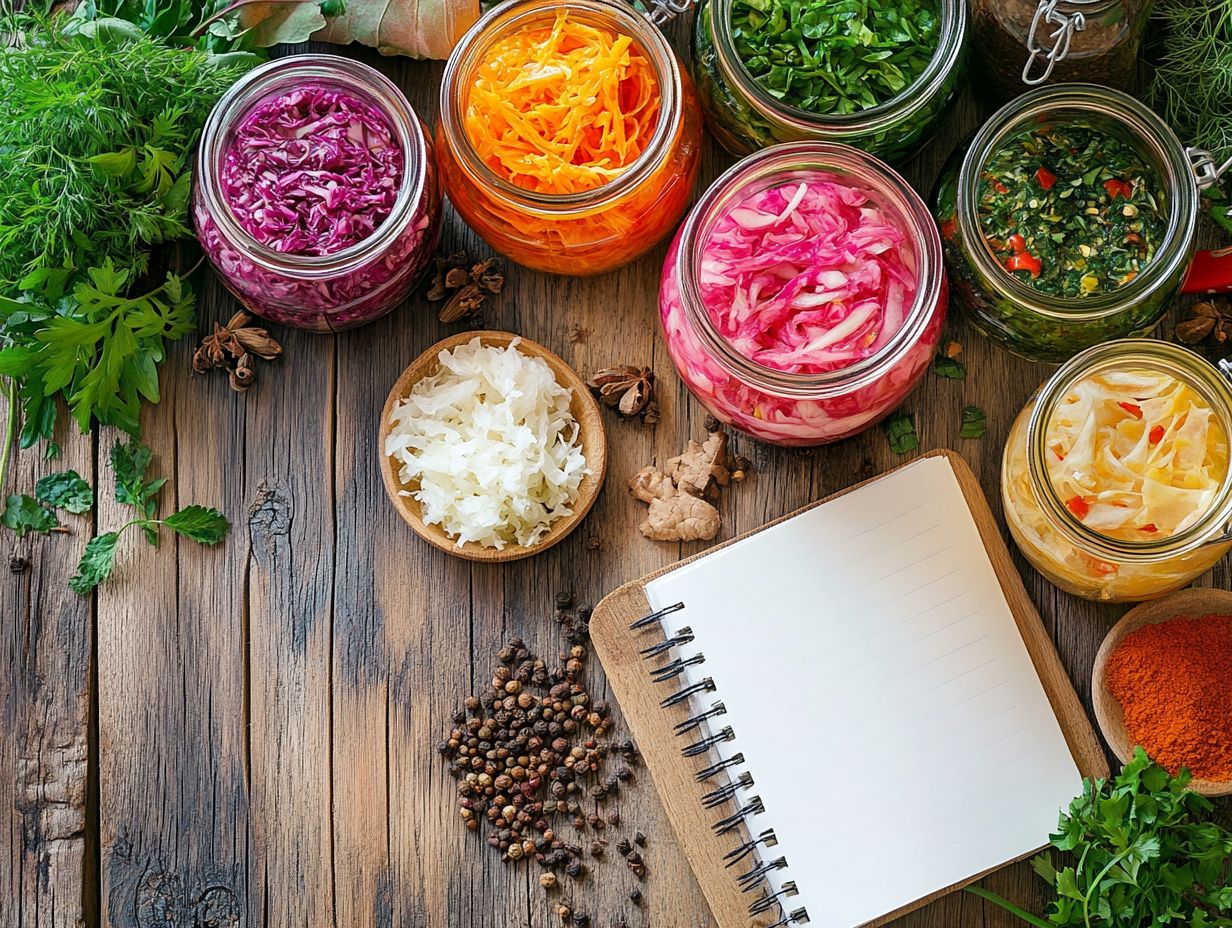
Jump into the exciting world of fermentation! Your first batch could lead to delicious discoveries and a healthier gut. To truly succeed in your fermentation experiments, it s essential to gather the finest ingredients think fresh vegetables, high-quality sea salt, aromatic garlic, and vibrant spices like turmeric or coriander.
You’ll also want to equip yourself with the right tools, such as jars and fermentation weights, to craft your own distinctive fermented foods in the comfort of your home.
What Ingredients Do You Need?
To begin your fermentation journey, gather a selection of essential ingredients: high-quality sea salt, fresh garlic, ginger, and an array of spices such as chili powder, turmeric, and cumin. These ingredients help fermentation and boost the flavors of your dishes. Crafting the right brine is crucial for successful lacto-fermentation, and these ingredients are key.
The quality of your ingredients will significantly influence the final outcome. Opting for organic vegetables ensures that harmful pesticides won t interfere with the fermentation process. Fresh garlic imparts a robust flavor while also delivering antimicrobial properties. Ginger serves as a natural preservative that promotes gut health thanks to its probiotic benefits. Spices like turmeric and cumin contribute unique flavors and help reduce inflammation, making your fermented delights not just tasty but also health-enhancing.
When sourcing these ingredients, seek out local farmers’ markets or organic grocers. You’ll find the freshest produce there, which will greatly enhance the nutritional value of your fermented foods.
Ready to start your fermentation journey? Gather your ingredients and let the fun begin!
What Equipment Do You Need?
In terms of fermentation, having the right equipment is just as crucial as sourcing the finest ingredients. Essential tools like glass jars, fermentation weights, and breathable lids create the perfect environment for your ferments, safeguarding your creations against contaminants and spoilage.
Temperature control is another key factor in your fermentation journey, making a fermentation thermometer a wise investment. This handy tool allows you to precisely monitor the fermentation process, helping you achieve those desired outcomes with confidence.
You might also find a pH meter to be invaluable, as it ensures your ferments reach the ideal acidity levels for both safety and flavor. If you’re ready to elevate your fermentation game, consider investing in fermentation crocks, which provide larger capacities and traditional features for a more authentic experience.
You can easily find these essential tools at local homebrew shops or online retailers specializing in fermentation supplies. With the right equipment in your arsenal, you’re well on your way to mastering the art of fermentation.
What Are Some Common Flavors Used in Fermentation?
Common flavors used in fermentation include a delightful array of aromatic and flavorful ingredients such as garlic, fresh ginger, and an assortment of spices like fennel, coriander, and chili powder. These ingredients do more than just enhance the taste of fermented foods; they also bring beneficial properties that promote gut health.
When you combine these flavors thoughtfully, you elevate the complexity of the fermentation process, impacting not only the taste but also offering a multitude of health benefits. For instance, adding turmeric to kimchi introduces earthy undertones along with its renowned anti-inflammatory properties, while dill adds a refreshing note to pickled cucumbers, transforming them into a delightful and nutritious snack.
Recipes like spicy fermented salsa, which melds tomatoes with jalape os and cilantro, or a tangy ginger-carrot kraut, showcase how diverse flavor elements can create unique profiles that tantalize the palate and support digestive wellness. By exploring various ingredient combinations, you unlock a world of creative possibilities in the fascinating realm of fermentation.
What Are Some Popular Fermentation Recipes?
Popular fermentation recipes like sauerkraut, kimchi, and kombucha not only exemplify the artistry of fermentation but also underscore its impressive health benefits, establishing them as staples in numerous households.
Each recipe presents a distinct flavor profile and an array of probiotic advantages, seamlessly integrating fermented foods into a balanced diet.
How to Make Sauerkraut
Making sauerkraut is not just a culinary endeavor; it s a simple yet immensely rewarding fermentation journey that requires only a handful of basic ingredients, with fresh cabbage and sea salt taking center stage. The essential steps involve shredding the cabbage, mixing it with salt to create a brine, and allowing it to ferment in a controlled environment for several weeks until it develops that irresistible tangy flavor.
To achieve the best results, you must start with high-quality, organic cabbage, as this choice directly influences the final taste of your sauerkraut. Once you ve shredded the cabbage, mix it thoroughly with the sea salt. This not only helps draw out moisture but also acts as a preservative, fostering the growth of beneficial bacteria that are crucial for fermentation.
During the fermentation process, it’s important to monitor the temperature to maintain that sweet spot of 65 to 75 F, as any fluctuations can significantly impact the outcome. Periodically tasting the ferment allows you to discover the perfect balance of flavors. Feel free to adjust the salt or spices as needed, crafting an end product that is uniquely satisfying and tailored to your palate.
How to Make Kimchi
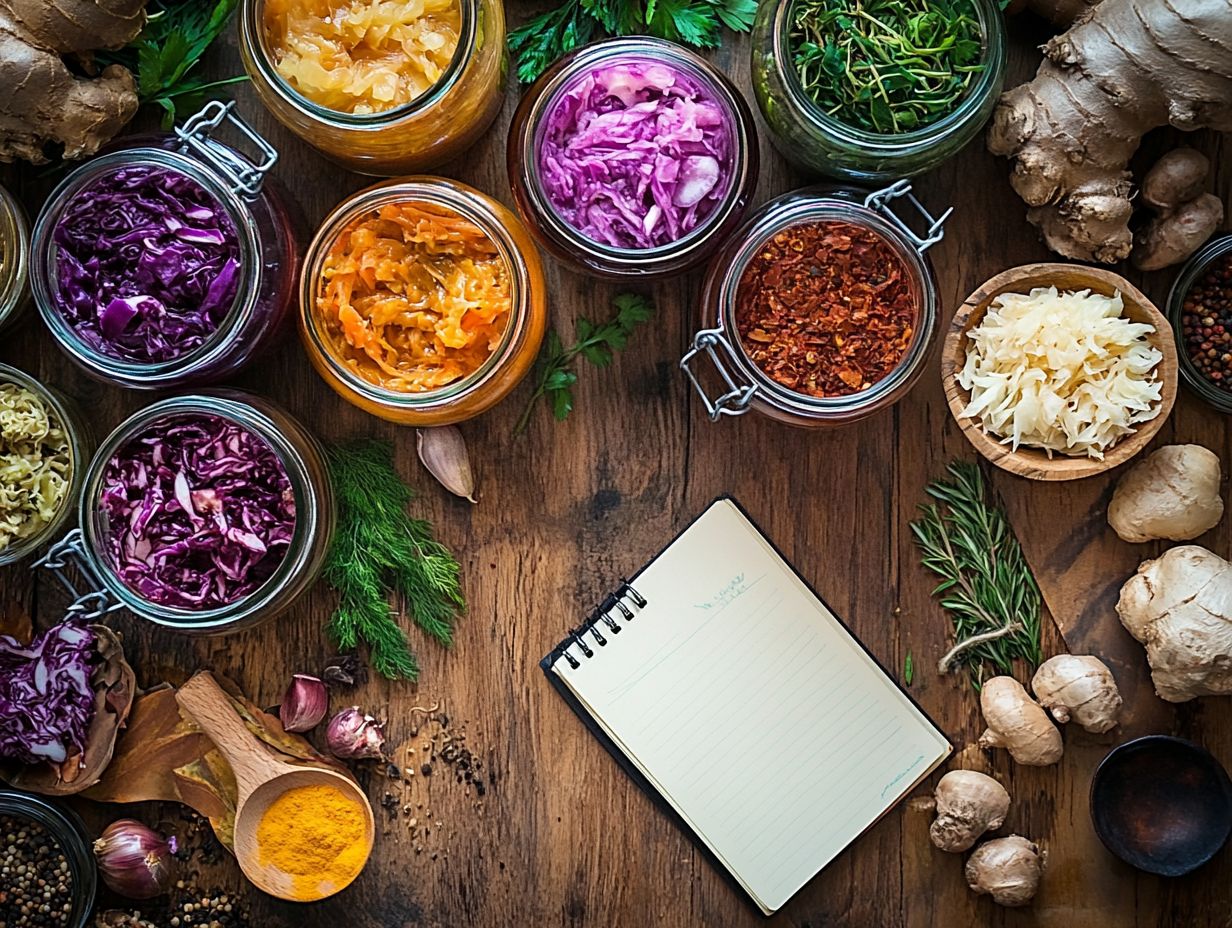
Kimchi is not just a dish; it’s a celebration of fermentation that captures the essence of Korean cuisine. Picture this: napa cabbage, garlic, chili powder, and an array of spices coming together to create something deliciously tangy and spicy. The magic begins with salting the cabbage to draw out moisture, then mixing it with the vibrant spice paste and letting it ferment for anywhere from a few days to a couple of weeks.
To embark on your kimchi-making journey, begin by selecting fresh, high-quality napa cabbage and crisp vegetables like radishes, which add that satisfying crunch. Once you ve thoroughly salted the cabbage and it starts to wilt, it s time to whip up a lively spice paste using gochugaru, ginger, and fish sauce. Feel free to adjust the heat level to suit your taste buds.
After combining the salted cabbage with this flavorful paste, pack the mixture into a clean jar to encourage the fermentation process. Keep in mind that the duration may vary depending on the temperature; warmer conditions will speed things up, resulting in a tangier final product.
Dive into the delicious world of variations like Baechu Kimchi or Kkakdugi! Each offers distinct textures and flavor profiles that range from sweet to spicy, showcasing the rich diversity found in Korean culinary traditions.
How to Make Kombucha
Brewing kombucha is a delightful journey that begins with steeping tea and allowing it to ferment with a symbiotic culture of bacteria and yeast (SCOBY). This exquisite process generally spans one to two weeks, depending on your flavor preferences and fermentation time. Once ready, you can elevate your kombucha experience by infusing it with fruits and herbs for an added burst of flavor.
To embark on this rewarding adventure of crafting your own kombucha, you ll need to gather some essential ingredients: tea, sugar, and of course, the SCOBY. This magical culture can often be obtained from a friend or easily purchased online.
As you complete the brewing phase, the fermentation stage begins. During this time, these beneficial microorganisms work their charm, crafting that distinctively tangy flavor that kombucha enthusiasts adore. Get creative; experimenting with additions like ginger or berries can lead to delightful results, enhancing both the taste and the visual appeal of your beverage.
Kombucha offers noteworthy health benefits, featuring probiotics that support digestion, antioxidants that combat free radicals, and potential detoxifying properties. It s no wonder this effervescent drink has become a trendy staple in wellness circles.
How to Incorporate Fermented Foods into Your Diet?
Incorporating fermented foods into your diet offers a delightful way to elevate your meals while reaping the myriad health benefits linked to probiotics and prebiotics.
Imagine adding a vibrant scoop of kimchi to your tacos, savoring a creamy dollop of yogurt alongside your breakfast, or sipping on a refreshing glass of kombucha. The possibilities are endless, allowing you to seamlessly weave these nutritious foods into your daily routine with ease and enjoyment.
What Are Some Ways to Use Fermented Foods in Cooking?
Fermented foods offer a world of creativity and flavor in your cooking endeavors. Imagine using kimchi in stir-fries, adding a dollop of yogurt to your salad dressings, or even marinating meats with kombucha. These versatile ingredients do more than just enhance the taste; they introduce beneficial bacteria that support your gut health.
For instance, a spoonful of miso paste can elevate your soups with a rich umami depth, while sauerkraut adds a delightful tangy crunch to tacos. Incorporating kefir into your smoothies not only boosts their creaminess but also delivers a healthy dose of probiotics. By embracing these fermented delights, you transform everyday dishes into extraordinary culinary experiences.
This approach not only diversifies the flavors on your table but also fosters a balanced digestive system. It truly is a win-win for those who crave exciting tastes and prioritize their health.
What Are Some Tips for Incorporating Fermented Foods into Your Daily Meals?
To seamlessly incorporate fermented foods into your daily meals, begin by adding small amounts to dishes you already enjoy. Gradually increase your intake as your palate becomes accustomed to these vibrant flavors.
Aim for a diverse selection of fermented options, such as sauerkraut, yogurt, and kefir, to fully benefit from their gut health advantages.
Incorporating these foods can be remarkably straightforward. For instance, simply add a spoonful of yogurt to your morning smoothie or use fermented vegetables as delightful toppings on salads and sandwiches.
To streamline this process, consider planning your meals around these ingredients at the start of each week. Why not prepare a weekly batch of fermented salsa or homemade kimchi to savor throughout the days ahead?
Feel free to get creative with flavors. Mixing different spices into your yogurt can add an exciting twist, or blending various fermented veggies can result in a colorful and tasty side dish.
The good bacteria found in these foods not only support digestion but also boost immune function, making them a valuable addition to anyone’s health regimen.
How to Troubleshoot Common Fermentation Problems?
Troubleshooting common fermentation problems is a critical skill for any home fermenter, as various issues can arise that impact the flavor and safety of your creations.
From off-flavors caused by unwanted bacteria to improper fermentation times leading to spoilage, mastering the art of identifying and addressing these challenges is key to ensuring successful outcomes in your fermentation endeavors.
What Are Some Common Issues When Experimenting with Fermentation Flavors?
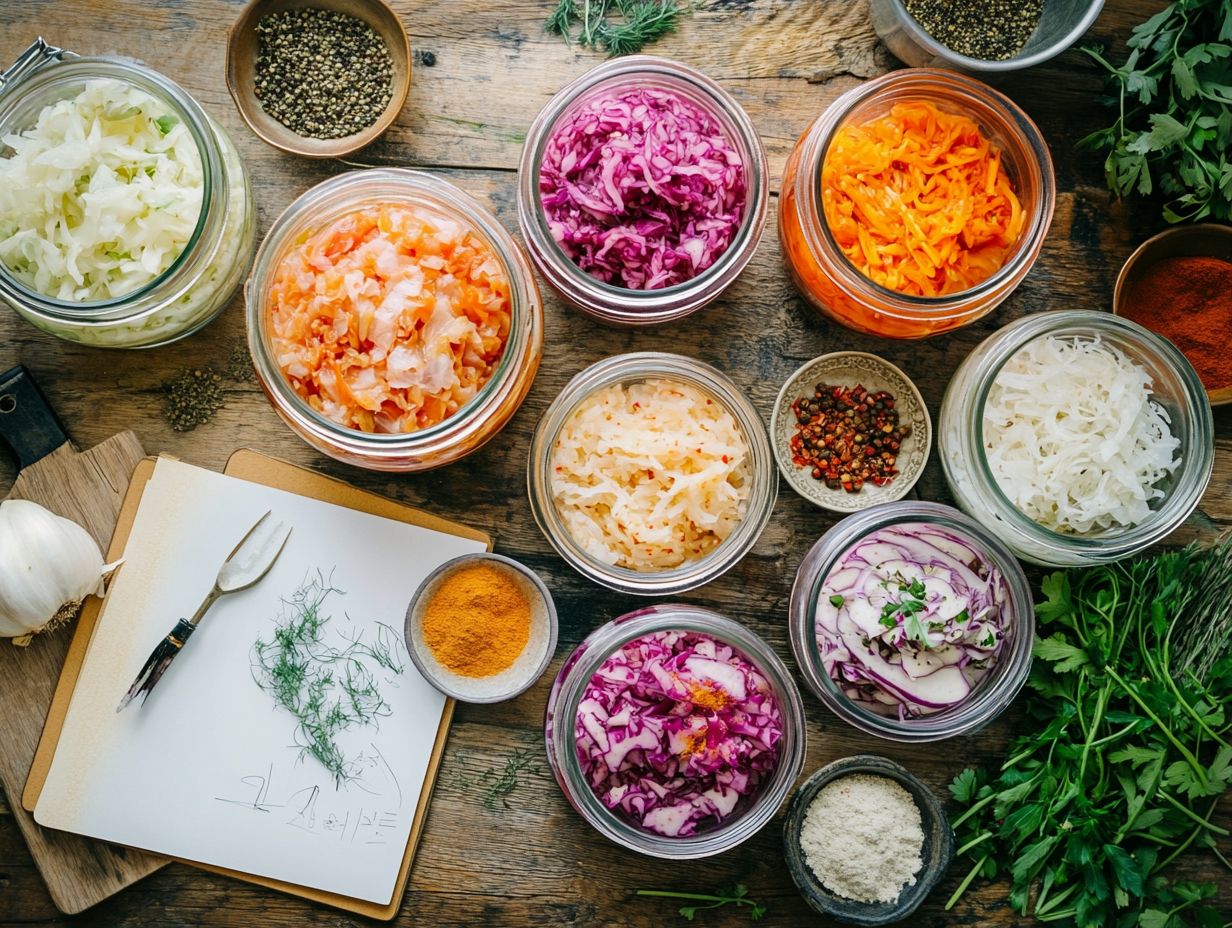
When you dive into the world of fermentation, be prepared for some common hurdles that can crop up, such as off-putting flavors, spoilage, and contamination from unwelcome microorganisms.
These challenges often arise from mismanaged fermentation parameters, like temperature or salt concentration, which can dramatically influence the success of your fermented creations.
For example, if you discover an overly sour flavor, it might be due to an overload of lactic acid bacteria (a type of bacteria that helps in fermentation) that flourished in excessively warm conditions, resulting in over-fermentation.
To counter this, keep a close eye on the fermentation environment with a thermometer and adjust the conditions as needed.
Sourcing top-notch ingredients, such as organic vegetables and high-quality starter cultures, can significantly improve your fermentation game. Don’t underestimate the power of precise measurements for salt aim for around 2-3% for vegetable ferments.
This not only helps ward off spoilage but also nurtures the right microbial environment.
Implementing strategies like keeping your fermentation vessels sealed and away from direct sunlight can further protect the quality of your final product. By taking these measures, you ll set yourself up for a successful and flavorful fermentation journey.
How to Fix and Prevent These Problems?
To address and prevent common fermentation issues, closely monitor the fermentation process. Adjust parameters like temperature, brine concentration, and ingredient quality to ensure you achieve optimal results.
Maintaining a clean workspace and relying on trusted recipes will significantly lower the risk of contamination and spoilage.
Before embarking on a new fermentation project, it s wise to conduct thorough research on the specific ingredients you plan to use. This includes understanding their individual sugar content, acidity levels, and how they might interact with other components in your mixture.
Utilizing tools such as pH meters and hydrometers can offer valuable insights, allowing you to fine-tune your process with precision.
Additionally, crafting a detailed timeline for the fermentation stages will enable you to monitor changes and make timely adjustments. By integrating these strategies, you can greatly enhance your chances of achieving a successful and flavorful ferment.
Frequently Asked Questions
What are fermentation flavors?
Fermentation flavors are the exciting and vibrant tastes that emerge from fermentation. Think sour, tangy, and funky notes found in delicious foods like yogurt, kimchi, and sourdough bread!
Why should I experiment with fermentation flavors?
Experimenting with fermentation flavors brings variety to your meals. Discover new tastes and whip up unique dishes that surprise your family and friends!
How do I start experimenting with fermentation flavors?
To start the fun of fermentation, pick your favorite food or beverage to ferment, such as vegetables, fruits, or grains. Then, gather a fermentation vessel and the necessary ingredients like salt, water, and starter cultures.
What is the best way to control fermentation flavors?
The best way to control fermentation flavors is by monitoring the temperature and time of the fermentation process. Different temperatures can produce different flavors. Additionally, longer fermentation times can result in stronger flavors.
Are there any health benefits to experimenting with fermentation flavors?
Fermentation offers several health benefits. It increases the levels of good bacteria in food, which can aid in digestion and improve gut health.
Is it necessary to use special equipment to experiment with fermentation flavors?
While specialized equipment like fermentation crocks can make the process easier, it’s not necessary to have them. You can use simple tools like mason jars or glass containers to ferment food at home.


